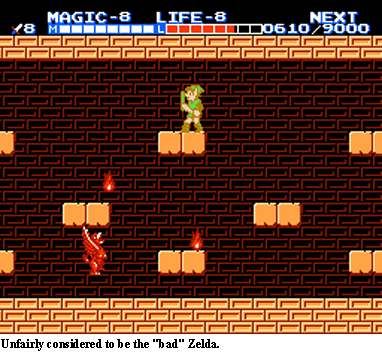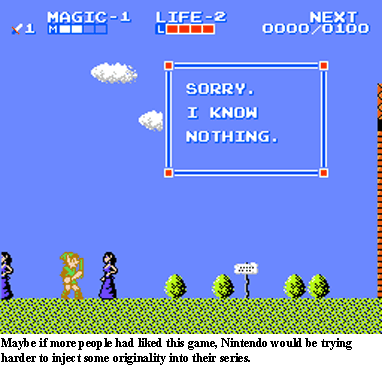It is unfortunate that so many people refused to accept the change that came with Zelda II. Nintendo, presumably trying to make a game that would appeal even more to American gamers than the first Zelda outing, produced what is relatively considered to be the ”bad” Zelda, due precisely to how beloved the original Zelda formula was and how wedded fans were to it. I, however, having never even played The Adventure of Link until after I had played and absolutely loved A Link to the Past, still happily embraced its decidedly different style. It’s not a simple extension of the first game of the series, but it’s still a great, groundbreaking game. Successfully blending sidescrolling action with RPG-style character development and story/puzzle-based gameplay, Nintendo took their two best genres and blended them with traditional role-playing elements into a stylish and deep game, which unfortunately never enjoyed the mass acceptance that the other Zelda games have.

Zelda II successfully blends three genre elements into one. The first and most apparent of these is the ”overhead action RPG” element, which is very similar to the original The Legend of Zelda. In Zelda II, this functions as the primary ”interface” of the game. You travel along on the overhead map, from which you can use certain items, enter caves or villages, and sometimes interact with your surroundings in primitive ways. The main difference here is that you cannot attack and are not attacked while in this mode. The battles themselves, as well as the dungeons, caves, labyrinths, and towns, are all presented from the side, à la Castlevania.
This is the second element that makes up Zelda II. Your basic moves in this mode include jumping, slashing, and ducking, though they can be updated or augmented with magic, items. and experience. When you wander from the safety of a paved road on the map, enemies represented by shadowy blobs and monsters begin to move about. Contacting with any of these draws you into a random battle scene, at which point you must fight or flee. Villages, palaces, caves, and other places that you intentionally venture into also feature this style of play, and you must talk to people, search for items, and explore the 2D terrain in order to advance the storyline.
This is where the third element that makes up the gameplay comes in. Random battles, experience points, and character interaction are all points taken from the traditional RPG. As your character gains experience, you can upgrade your health, strength, and magic all to your liking, and not bothering to do so will leave you hopelessly vulnerable in the later parts of the game. Also, carrying out tasks based on what clues other people give you lead you to spells and items that are necessary to proceed, and sometimes to rewarding secrets.
So how does all this mixing turn out in the finished game? Seamlessly. All the elements blend together, never distracting or confusing. The game is self-explanatory, and it only takes a few minutes to get used to. Mastering it, however, is another story.
You start out in Zelda II standing (from the side perspective) at the bottom of a set of steps leading up to a sleeping princess, presumably (in case you don’t have the instruction booklet, which features a very detailed, and what is my favorite yet, Zelda story) Zelda. As Link, you’ve got to return six jewels to the foreheads of some creepy statues in order to wake Zelda up from the sleep induced by Ganon. Where are the statues? As you can probably surmise, they’re each hidden deep within a series of palaces, and every palace is controlled by Ganon and his evil goons. This is bad news for Link, but good news for us.
Each palace is a complex labyrinth filled with a wide variety of enemies and requiring dexterity and perseverance. You have to search for the palaces, and then get inside and find your way out all within three tires. But it’s not quite that simple. There are forests, boulders, rivers, and even huge road-blocking demons standing in your way. You’ve got to spend some time between each palace to find your way to the next. All this adds up to hours and hours (probably at least 10 the first time through) of intriguing gameplay. And you’ll probably want to play through it more than once, especially since there is a ”second quest” available once you beat the game that’s extremely fun.

But all is not perfect in Hyrule this time, and some parts of Zelda II have me longing for the original Zelda along with the masses of game players of the day. For starters, this game is decidedly more linear than its predecessor. The grand sense of exploration that pervades the original Zelda is lost here to more clean-cut, objective-based gameplay. Sure, there are a few secret items here and there, but nothing that can truly be called a sidequest. Also, some of the executions of said linear tasks are a bit too needlessly time-consuming, if not flat-out frustrating. Having the location of a key item narrowed down to a particular forest, but then having to search that forest block by block while being attacked by enemies every three seconds, is not my idea of puzzle-solving.
Secondly, Zelda II features a limited number of tries per game. After you use up your tries, you must start back at the very beginning. This can often lead to repetitive journeys through enemy-infested continents after each failed attempt to finish a palace. It doesn’t sound that bad, but I would rather have had a simple addition to this feature of being allowed to restart at the entrance to a palace within which you died, thereby alleviating the pain of having to travel back from step one, but still forcing you to finish each palace with only your allotted three tries. Fairly, though, you do eventually gain items that allow you to take shortcuts, but those of us who are used to the modern conveniences like state-saves, Zelda II may seem a little discouraging.
All in all, The Adventure of Link is engaging, challenging, unique, and great fun, if a bit linear and frustrating. As an adaptation of several different genres, it isn’t anywhere near what the third Zelda was to the first, but I contend that it does have the Zelda ”feel”, and that most fans should enjoy it if they give it a chance.
By far the best thing about Zelda II‘s graphics is the look of the sidescrolling aspect. Link was only one ”block” before, and he still is on the overhead map view here, but when the action sequences unfold, you see him and all the enemies in a new light. No longer short and pudgy, Link is now a tall, slender boy with twice the graphical detail making him up. The enemies also sport a much higher level of detail, including some as tall as or taller than Link.
The environments vary a great deal. I don’t think another Zelda game had quite as great a sense of geographical vastness until Majora’s Mask. In the northmost area lies a desert, with an ocean as its boundary. Paved roads lead to murky caves, which open to swamps, rivers, and forests. Haunted graveyards and cities ranging from vibrant to deserted to destroyed are scattered about. A labyrinth version of Death Mountain is included, as well as islands, inlets, and the obligatory fire and lava area. The only thing missing is snow! Each type of area features a different color scheme, from the ominous purple skies in the graveyards to the bright blue behind the towns. The palaces themselves are also all unique, boasting different themes of statues, architecture, and, of course, enemies. The only gripe is the brick backgrounds in these levels. The scrolling brick patterns seems to flicker, and this can be a bit hard on the eyes.
The end result is a colorful and realistic visual portrayal of the land of Hyrule that bests similar efforts in almost every way. Zelda II‘s graphics really give you the sense that you are traveling across a huge body of land and undertaking a dangerous adventure that could make a complete thematic change at any moment.
Just because Zelda II features mostly sidescrolling gameplay, don’t expect a recycling of the Super Mario Bros. machine. This combat engine has been specifically designed for pattern-based swordplay. It is mildly reminiscent of the original Castlevania, though it thankfully allows us to move mid-jump.
First, there is no run feature. Link constantly runs at a steady speed, and he reaches his highest speed in about 0.5 seconds. Once he is running, he can jump further. Furthermore, tapping the jump button and holding it do not result in the same height difference that they do in most platform games. Link has a shield, and you must visually line it up with the projectile or weapon you wish to block, either by ducking or jumping.
Link can also slash a short distance with his sword. In order to successfully defeat an armored enemy, you must attack their weak points and then move out of harm’s way before you are counterattacked. Different enemies require different strategies, making for a battle system with a very fair learning curve. When Link himself is hit, he is knocked back and does the typical ”flash momentarily” thing to give the player a chance to regain his wits, and when he strikes a wall or an enemies armor/shield, he is pushed back a bit as well. Herein lies is the only thing that irks me about Zelda II‘s controls: When Link takes damage and flies backward, you lose control of him until he hits the ground. This is a common style in sidescrolling action games, but I detest it. I just don’t like being forced to fall into a pit when I could be given a chance to save myself. This complaint is a matter of opinion and style, so I can’t really deride the game for it. Zelda II‘s controls are responsive, workable, and suited to the type of play involved.
I’ve always been impressed by good-sounding music on the NES. It must be a truly demanding art form to make a few square wave frequencies and that awful drum hiss ”noise” sound like real music. Even in the company of the greatest tunes of the system, Zelda II has got to feature some of my absolute favorite music. The mutated ”overworld theme” bolsters my heroic spirit. The relentlessly foreboding dungeon music intimidates me. The towns feel relaxed and soothing. HAL knew it when they made Super Smash Bros. Melee, and I agree with them. Zelda II has some of the most under-appreciated music in all of gamedom. I keep a homemade soundtrack in my CD player to this day, in fact.
The sound effects are equally worthy of the Zelda franchise. The clanging of swords, Link’s grunts of pain, and the relieving song of the fairy are all beautifully rendered. Little detailed extras, like the sound of Link landing on the ground and that of a projectile dissipating against or bouncing off of his shield, are the icing on the cake. When you die, Gannon mocks you with a booming laugh. These sounds are the pinnacle of NES audio, from before the dumb obsession with digitized speech and overdone, unrealistic realism later in the system’s life.

It’s sad that this game wasn’t more loved by players. Had it been, Nintendo might have been more encouraged to inject some originality into their other franchises. But even as the black sheep, The Adventure of Link deserves a place among its brothers, and the same respect.
